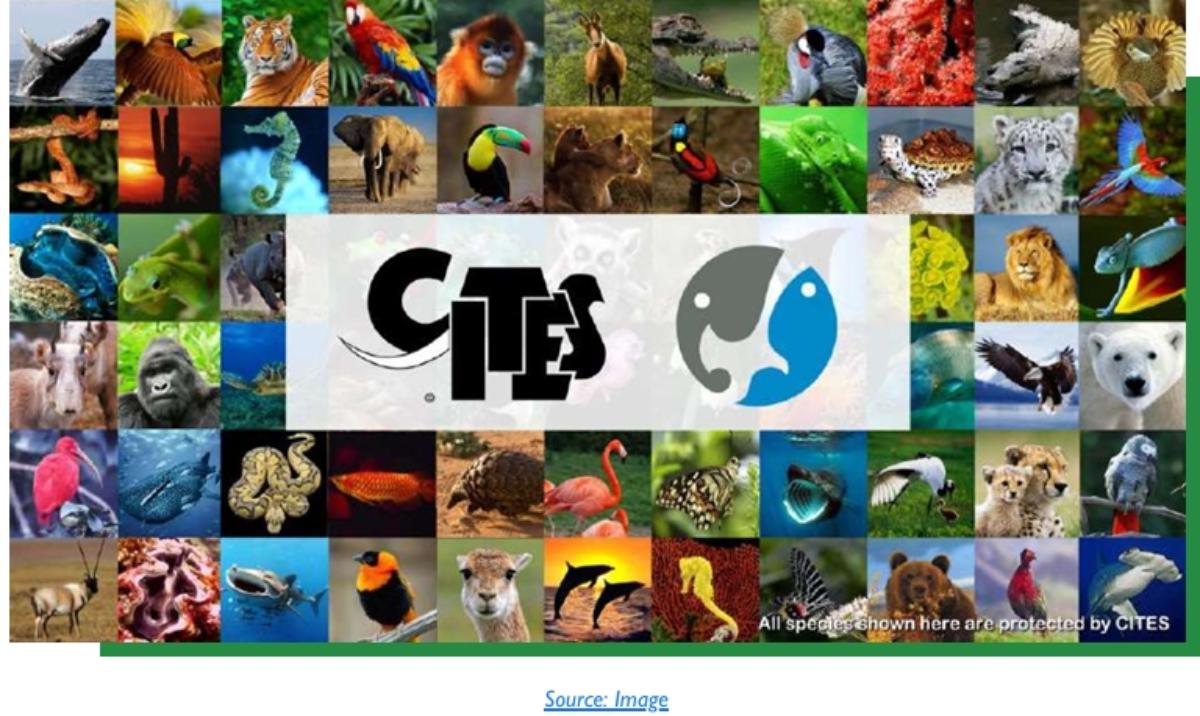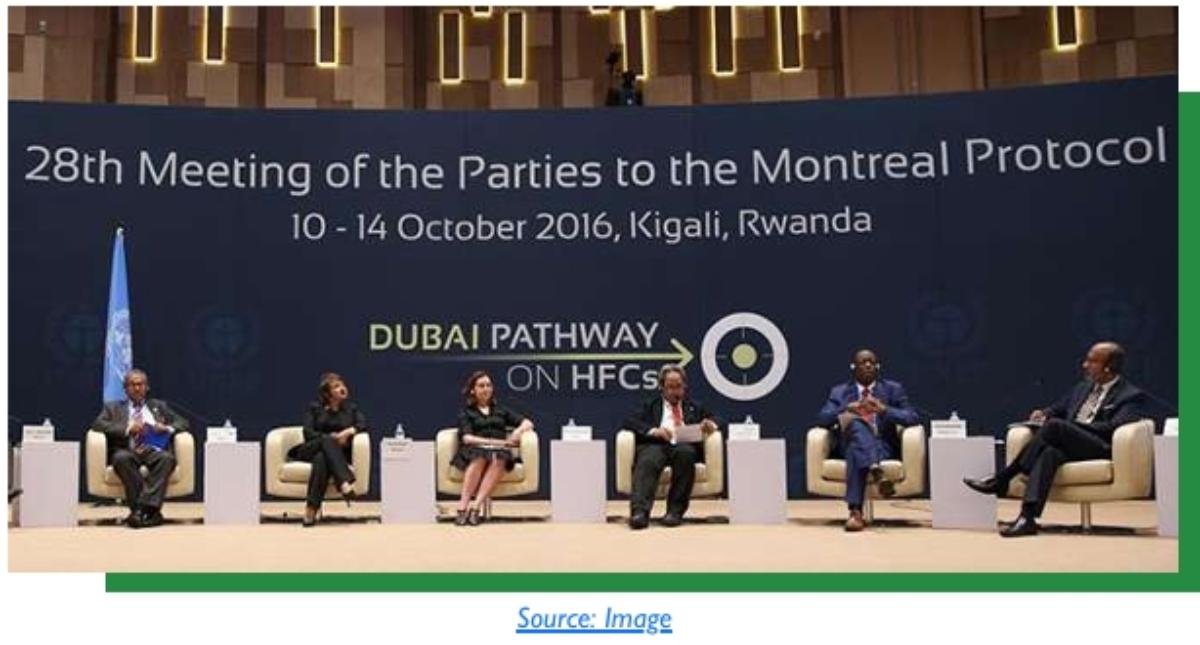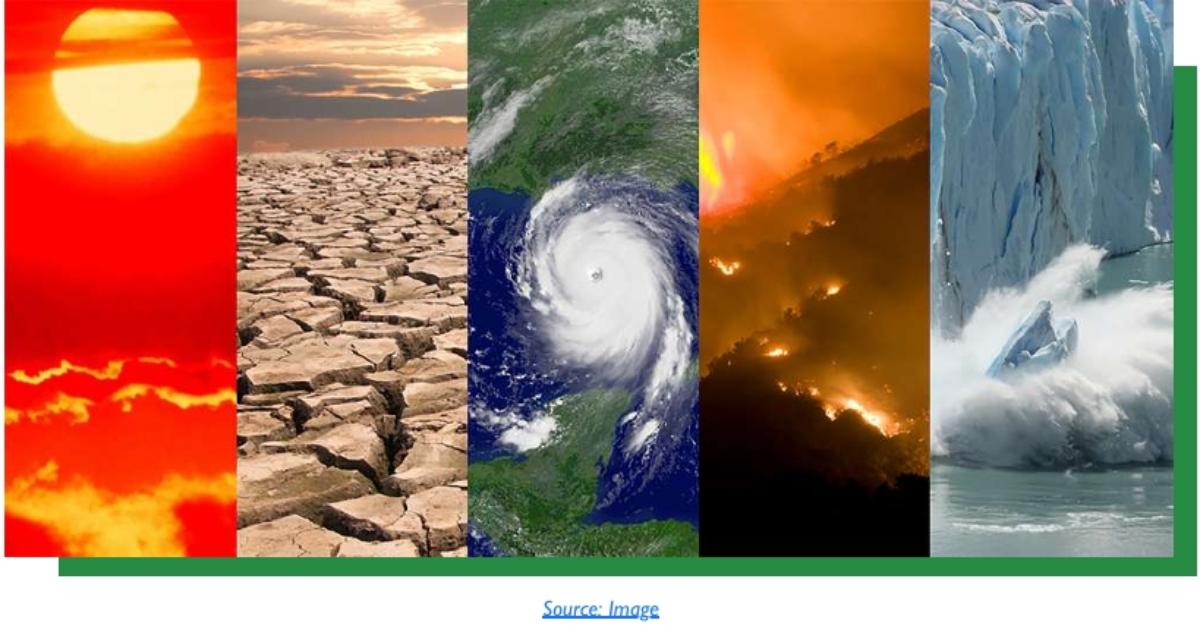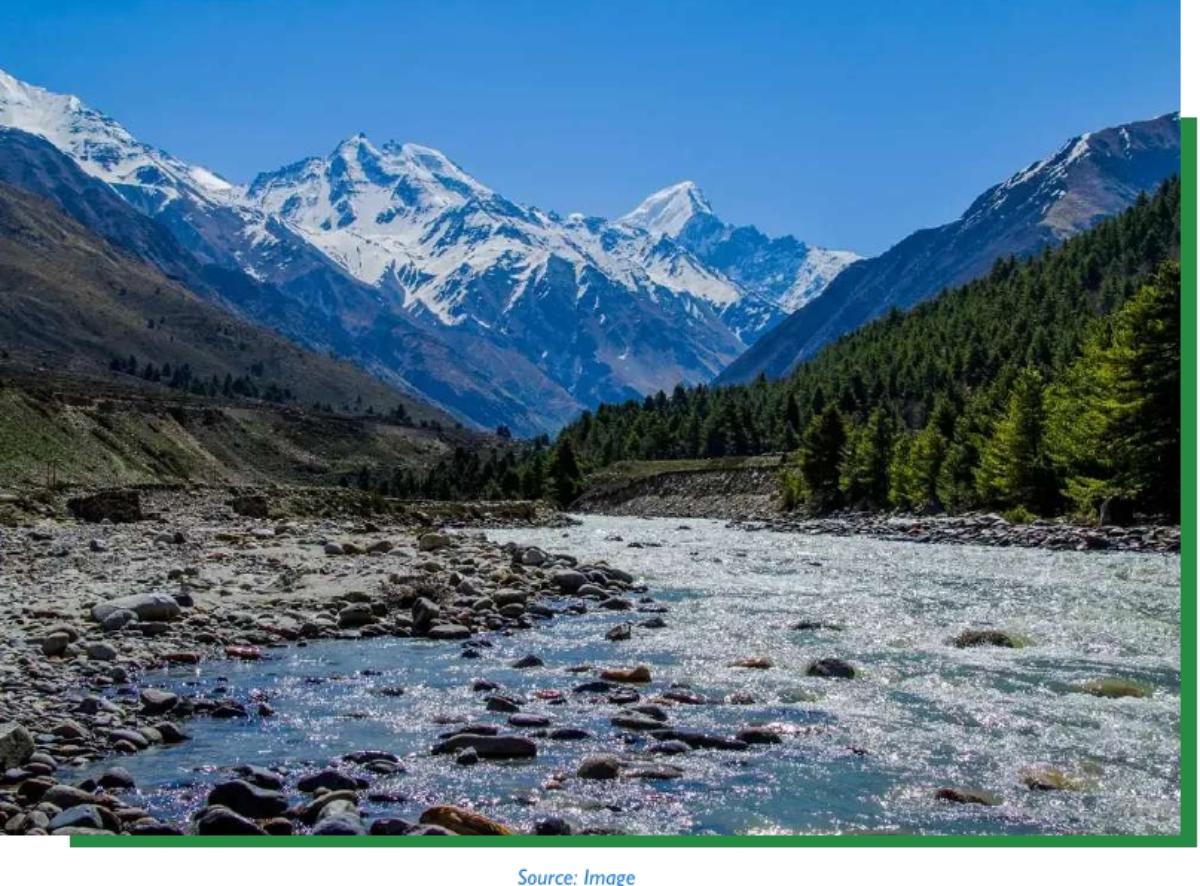Introduction
India has played an important role in international action for environmental conservation and sustainable development. One of the first global conferences on environment was held in Stockholm in 1972. India’s Prime Minister at the time, Indira Gandhi, was the only foreign head of government out of 113 nations in attendance. Her speech at the conference was ground-breaking in that it linked environmental conservation with poverty reduction.[1]
Within the global environmental action framework, various themes guide international efforts towards sustainability and protection. Among these, themes such as Biodiversity and Conservation, Protection against Degradation of the Environmentand Climate Change stand out prominently.
- Under the theme of Biodiversity and Conservation, conventions like the Ramsar Convention prioritize the preservation of wetland ecosystems, while treaties such as CITES regulate international trade to safeguard endangered species.
- In addressing Protection against Degradation of the Environment, initiatives like the Montreal Protocol focus on phasing out ozone-depleting substances and the and treaties such as the Minamata Convention, targeting global mercury pollution reduction, stand out.
- Efforts to reduce greenhouse gas emissions which cause climate change, have been led by the United Nations frame-work Convention on Climate Change and several other initiatives such as the Kyoto protocol and the Paris Agreement.
Collectively these agreements and initiatives underscore the interconnectedness of global environmental challenges and the importance of collaborative action for a sustainable future.
In this article we have listed eighteen important environmental conventions/agreements/ protocols under the three themes mentioned above. Each of these have been described briefly, specifying their objective, scope and modus operandi.
Out of the 18 agreements listed, we have chosen six concerning – two each covering biodiversity conservation, addressing environmental degradation andclimate change, have been selected for studying their implementation status by India. These six include the Ramsar Convention, for preserving wetlands, the Convention on Biological Diversity (CBD), United Nations REDD+ program, aiming to reduce emissions from deforestation and forest degradation; the Montreal Protocol and the Kigali Amendment, for phasing out ozone-depleting substances; the United Nations Framework Convention on Climate Change (UNFCCC), and the Paris Agreement.
Though India has signed all these conventions/agreements/protocols, and remains committed to implementing them, bottlenecks remain in implementation. In this article, using literature survey, the main bottlenecks have been identified and some suggestions have been made for overcoming those to enhance the implementation.
Biodiversity Conservation

Biodiversity is a source of essential sources, resources and ecosystem services that sustain human life, including food production, purification of air and water and climate stabilization. Moreover, the conservation of biological diversity, the sustainable use of its components, and the fair and equitable sharing of the benefits are essential to ensure a prosperous future for both the natural world and human societies, making it a critical theme to be chosen when assessing the implementation status of treaties such as Ramsar, Bonn Convention, 1979 on the Conservation of Migratory Species, Nayoga Protocol, Cartagena (for instance).[2]
Ramsar Convention on Wetlands, 1971
The Convention on Wetlands, established in Ramsar, Iran in 1971,which came into effect in 1975, aims to conserve and sustainably manage wetland ecosystems globally.
Under the text of the Convention (Article 1.1), wetlands are defined as: “areas of marsh, fen, peatland or water, whether natural or artificial, permanent or temporary, with water that is static or flowing, fresh, brackish or salt, including areas of marine water the depth of which at low tide does not exceed six metres”. In addition, for the purpose of protecting coherent sites, the Article 2.1 provides that wetlands to be included in the Ramsar List of internationally important wetlands: “may incorporate riparian and coastal zones adjacent to the wetlands, and islands or bodies of marine water deeper than six metres at low tide lying within the wetlands”.[3]
India became a party to the Convention in 1982.[4]With 172 contracting parties worldwide, representing nearly 90% of United Nations member states, the treaty designates over 2,500 wetlands covering a total area exceeding 257 million hectares. India, a contracting party since 1982, has 80 Ramsar sites spanning approximately 1.33 million hectares. These sites play a crucial role in biodiversity conservation, water regulation, and providing habitats for countless species, highlighting the importance of international cooperation in preserving these vital ecosystems.[5]
Wetlands earn a spot on the List of Wetlands of International Importance due to their ecological, botanical, zoological, limnological, or hydrological significance. Yet, over time, the Convention has evolved to acknowledge wetlands not only for their biodiversity value but also for their crucial role in sustainable development. Thus, the Convention now fully embraces the diverse importance of wetland ecosystems as outlined in its text.[6]
In India, the convention has been in place since 1982, with a total of 80 Ramsar sites covering a surface area of 1.332.200 ha,[7] and stands first in South Asia and third in Asia in terms of number of designated sites.Under the convention, “wise use” is a critical component, which is broadly defined as maintaining the ecological character of a wetland. The major problems with respect to wetland protection in India are
- encroachment of wetland peripheries, and sometimes even the main tracts
- blocking of water inlets and outlets due to human settlements, industries, roads, etc.
- pollution of various kinds including chemical fertilisers and pesticides in rural areas
- plastic waste, sewage and industrial effluents including chemicals and heavy metals in urban areas – for instance, plastic bags, bottles and other wastes dumped in several wetlands across the country and from various lakes settle to the bottom and adversely affect bottom feeders. A decline in carnivores and a dominance of omnivores (58%) followed by 6% herbivores, 6% larvivores, and 2% detritivores also indicates organic pollution.[8]
- alteration of species composition and spread of invasive species of flora and fauna.
For several wetlands across India, the discharges of industrial effluents contaminate and pollute them, additionally, the pollution load index indicates that the sediment/s are heavily polluted, for example, what is common is severe and moderately severe increaseof Cadmium and Zinc with minor increase of Lead, Chromium and Mercury- this causes long term degradation which results in the loss of ecosystem services in the wetland.
In Kerala, issues of anthropological pressure by extensive encroachments have changed the land-use of the wetland for agriculture, especially rice cultivation. There is, thus, a need for cross state policies, to update laws and protocols on how to reduce extensive encroachments changing the land-use of the wetland for agriculture, especially rice cultivation in India, an important source of livelihood for most of its workforce. Fostering collaboration and monitoring efforts with other countries to share knowledge, best practices and biodiversity and livelihood protection is important given the scale of effort required by India to safeguard and protect its biodiversity as well as the livelihood/s associated with it.[9]
India should have concerted efforts toward restoring and conserving wetland ecosystems which may involve measures such as hydrological connectivity, controlling invasive species, and implementing habitat restoration projects.Learning from other countries, India must focus on reducing plastic pollution and other forms of litter, which pose significant threats to aquatic life in wetland environments, specifically.
Convention on International Trade in Endangered Species of Wild Fauna and Flora (CITES), 1975

CITES, established in 1975, safeguards endangered species by regulating international trade. With 184 member nations, CITES classifies species into Appendices I[i], II, and III and since wildlife trade crosses borders, international cooperation is necessary, with CITES providing varying levels of protection to over 40,000 species today.[10]In the endeavour to remain at the forefront of international sphere, India became a party to CITIES in 1976 to ensure that it remains at the forefront of wildlife convention and international cooperation.[11]
CITES combats illegal wildlife trade, ensuring sustainability, while fostering global cooperation for biodiversity conservation.India, a mega-diverse country, hosts significant biodiversity and traditional knowledge. As a CITES Party, it regulates international trade to protect endangered species.[12]
The international wildlife trade involves billions of dollars and millions of animals and plants annually. Some species are heavily exploited, threatening their survival. While not all traded species are endangered, having the CITES agreement to ensure sustainable trade is crucial.
Bonn Convention, 1979 on the Conservation of Migratory Species
Signed in 1979, the Convention on the Conservation of Migratory Species of Wild Animals (Bonn Convention; CMS) is an environmental treaty under the aegis of the United Nations Environment Programme (UNEP), providing a global platform for the conservation and sustainable use of migratory animals and their habitats.
The Convention on the Conservation of Migratory Species emphasizes protecting migratory species, especially those with unfavourable conservation status. Parties aim to promote research, conclude agreements for species listed, and provide immediate protection for Appendix I species – with the aim to conserve habitats, minimize migration obstacles, and address endangering factors. Furthermore, given the grave threat of species extinction and the need for protection to the species under Appendix 1,parties also are required to prevent or minimize effects of harmful practices, except for specific purposes.[13]
Agreements for Appendix II species covers migratory species that have an unfavourable conservation status and that require international agreements for their conservation and management, as well as those that have a conservation status which would significantly benefit from the international cooperation that could be achieved by an international agreement.Additionally, there is a supporting article IV (4), under whichagreements can be made for any population crossing national boundaries. The Conference of the Parties reviews convention implementation and can adopt recommendations with amendments being possible. Disputes are resolved through negotiation or arbitration.[14]
Convention on Biological Diversity, 1988
In November 1988, experts convened to explore the need for a biodiversity convention. The Convention on Biological Diversity, signed by 168 countries, aimed for conservation, sustainable use, and equitable benefit-sharing. Parties implement it through national plans and reports, aligning with global targets. India, a signatory since 1993, aligns its efforts with the CBD through legislative frameworks like the Biological Diversity Act (2002). India’s National Biodiversity Action Plan (NBAP), first drafted in 1999 and updated periodically, reflects its commitment to CBD objectives. With 12 National Biodiversity Targets (NBTs) in place, India strives to meet global biodiversity goals while addressing national priorities.[15]
The Union Ministry of Environment and Forests (MoEF) of the government of India has been designated the Nodal Agency with the responsibility of implementing the Convention of Biological Diversity in the country. The MoEF involves a number of other ministries, departments, institutions and NGOs as major partners for developing and implementing national strategies on conservation and sustainable use of biodiversity.

Objectives highlighted in the National Report 6, submitted to the CBD in December 2018, have National Biodiversity Targets (NBTs) which aim to address different aspects of biodiversity conservation in a focused manner. For example, NBT 3 targets habitat degradation and loss, NBT 5 emphasizes sustainable management practices, and NBT 7 focuses on conserving genetic diversity.[16]
India has overachieved the ACHI 11 target of 20% of total biological area under conservation and as of 2020, more than 20% of India’s land has been set aside for conservation and protected areas, particularly those crucial for biodiversity and ecosystem services, are conserved through effectively managed, ecologically representative systems. These areas are well connected and integrated into wider landscapes and seascapes.[17]
In addition, following the Nagoya Protocol, certificates have been issued showing that benefit sharing, access and management of biodiversity has been adhered in an internationally recognized manner and India has received a certificate of compliance (IRCC) under the Protocol in 2015.
India’s Environment Minister stated that India is on track to meet the 30×30 conservation target by 2030, with nearly 27% of the country’s area already under some conservation measure. However, challenges like infrastructure gaps, connectivity issues, neglected ecosystems, and the need for financial support from developed nations persist.[18]
In India, realising the importance ofEnvironmental Information, the Government of India, established in December, 1982, established an Environmental Information System (ENVIS) which plays a vital role in implementing the Convention on Biological Diversity (CBD). ENVIS has been providing environmental information to decision makers, policy planners, scientists and engineers, research workers, etc. all over the country.
ENVIS serves as the National Focal Point and Regional Service Centre Information System for the South Asian Sub-Region within the INFOTERRA network, supported by UNEP. Additionally, ENVIS is designated as the National Focal Point of Sustainable Development Network Programming by UNDP. It functions as the Clearing House Mechanism for the CBD in India, facilitating information exchange crucial for biodiversity conservation. ENVIS also collaborates closely with national systems like NISSAT and Biotechnology, enhancing integration and effectiveness in CBD implementation.[19]
However, such institutions, which often are responsible for conservation, lack the necessary resources and expertise to effectively implement conservation measures. This is evident where the management of marine protected areas has been criticized for its reliance on training and experience geared towards terrestrial ecosystems. The absence of specialized expertise in marine conservation highlights the institutional capacity gap that needs to be addressed.
Other bottlenecks in implementation have been identified, such as ,despite commitments made by countries, the current level of funding falls short of the estimated biodiversity finance gap, with a need for substantial increases in financial resources to bridge this gap. For instance, while the Global Biodiversity Framework (GBF) sets ambitious targets, such as mobilizing at least $200 billion annually by 2030, reports indicate that the annual biodiversity finance gap ranges from USD 598-824 billion. This lack of adequate funding presents a significant barrier to implementing conservation measures effectively.
Regulatory shortcomings pose another obstacle to effective conservation. While the Forest Rights Act of 2006 protects the land and access rights of forest-dwelling communities in terrestrial protected areas in India, there is no equivalent statute safeguarding the rights of fishing communities in marine protected areas. This regulatory gap underscores the need for comprehensive legal frameworks that address the diverse conservation challenges across different ecosystems.[20] **
Cartagena Protocol on Biosafety, 2003
The Cartagena Protocol on Biosafety is an international agreement linked to the Convention on Biological Diversity. India signed it in 2003. The Protocol focuses on managing the risks of genetically modified organisms (GMOs) from modern biotechnology. It requires countries to establish a Biosafety Clearing House (BCH) to share information on GMOs. The Protocol emphasizes caution and thorough evaluation of new technologies. It also gives developing countries the freedom to balance health and economic concerns.
Moreover, the Cartagena Protocol on Biosafety (CPB) focuses on regulating the transboundary movements of Living Modified Organisms (LMOs), ensuring countries have necessary information for informed decision-making. By doing so, it distinguishes LMOs from GMOs to exclude non-living products derived from them. The Protocol promotes biosafety through procedures for border movements, risk assessment, a biosafety clearing house, capacity building, and public awareness.[21]

Moreover, countries are empowered to prohibit GMO, or, genetically modified, imports in the absence of sufficient scientific evidence attesting to their safety, and exporters are mandated to label shipments containing genetically altered commodities like corn or cotton.
Nagoya Protocol on Equitable Genetic Resource Utilization, 2014
The Nagoya Protocol, effective since October 12, 2014, seeks to ensure fair and equitable sharing of benefits from genetic resource utilization. This international agreement under the Convention on Biological Diversity emphasizes the importance of mutually beneficial relationships between providers and users of genetic resources. India enacted domestic legislation in 2002 to address this and the Nagoya Protocol, has thus been in force since October 12, 2014, withprovisions facilitating effective implementation of Access and Benefit Sharing (ABS). It covers benefits from GRs outlined in Article 15 of the Convention and associated traditional knowledge, ensuring equity for Genetic Resources and Traditional Knowledge providers domestically and internationally.[22]
India’s implementation of the Nagoya Protocol included a legal framework, institutional mechanisms, stakeholder engagement, capacity building, benefit-sharing mechanisms, compliance monitoring, international cooperation, awareness campaigns, information systems, and an emphasis on sustainability and biodiversity conservation, exemplified by initiatives such as the India Business and Biodiversity Initiative.[23]
Protection Against Degradation of the Environment
The second theme chosen is, degradation of the environment and this is important because over consumption of natural resources results in environmental degradation, reducing the effectiveness of essential ecosystem services, such as the mitigation of floods, and the reduction of landslides, which causes increased risks from disasters, and in turn, natural hazards which can further degrade the environment. The theme chosen also reflects issues such as deforestation, crop yields reduction, and water shortages all of which also contribute to long term effects of inequality, food insecurity and poverty.
Vienna Convention on the Ozone Layer, 1988/2009
The Vienna Convention, signed by all participating nations in 1988 and achieving universal ratification by 2009, stands as a landmark in global environmental cooperation. India ratified the Convention on June 19, 1991, underlining its commitment to addressing ozone layer depletion.[24] The Convention’s inception reflected widespread concern over ozone depletion and signalled a global resolve for collaborative action.
The primary aim of the Convention was to foster international cooperation by facilitating the exchange of information on human activities’ impacts on the ozone layer. Parties were expected to adopt legislative measures to protect human health and the environment from ozone depletion, focusing on understanding physical and chemical processes, health impacts, and climate effects, while exploring alternatives.
Parties to the Convention facilitate technology transfer, exchange information, and report implementation to the Conference of the Parties (COP), which oversees, reviews, and promotes harmonized policies. The COP serves as a platform for settling disputes and is supported by a secretariat, playing a pivotal role in fostering global cooperation on climate change.[25]
Montreal Protocol to Safeguard the Ozone Layer, 1992
The Montreal Protocol, adopted in 1987, represents a ground-breaking international effort to safeguard the Earth’s ozone layer. It targets nearly 100 man-made chemicals known as ozone-depleting substances (ODS), such as chlorofluorocarbons (CFCs) and halons, which, when released into the atmosphere, degrade the ozone layer. The Protocol sets out specific measures for the phasedown of ODS production and consumption, with developed and developing countries committing to different timelines for implementation.
The Montreal Protocol, in effect for three decades, successfully eliminated 99% of ozone-depleting substances, aiming to restore the ozone layer by 2070. Without it, the Antarctic ozone hole would have been 40% larger by 2013. The Protocol prevents an estimated 2 million skin cancer cases yearly by 2030.[26]
Additionally, it establishes mechanisms for monitoring, reporting, and compliance verification. By reducing ODS emissions, the Protocol aims to mitigate ozone depletion, thereby protecting human health, ecosystems, and the environment from harmful ultraviolet radiation.[27]
Rio Summit – The UN Conference on Environment and Development, 1992

The UN Conference on Environment and Development (UNCED) in Rio de Janeiro, 1992, known as the ‘Earth Summit’, united global leaders, scientists, and Non-Governmental Organizations to address the intertwined impacts of human activities on the environment. Emphasizing interdependence, it promoted sustainable development, integrating economic, social, and environmental concerns. The summit highlighted the need for holistic approaches to production, consumption, and decision-making.
“The ‘Earth Summit’ had many great achievements: the Rio Declaration and its 27 universal principles, the United Nations Framework Convention on Climate Change (UNFCCC), the Convention on Biological Diversity; and the Declaration on the principles of forest management . The ‘Earth Summit’ also led to the creation of the Commission on Sustainable Development, the holding of first world conference on the sustainable development of small island developing States in 1994, and negotiations for the establishment of the agreement on straddling stocks and highly migratory fish stocks.”[28]
Agenda 21 emerged as a pivotal outcome, as it emphasized the importance of aglobal action plan for sustainable development, calling for integrated approaches to address poverty, hunger, ill health, illiteracy, and ecosystem degradation. The declaration stresses the need for a global partnership, financial resources for developing countries, attention to economies in transition and provides a framework for coordinated action and collaboration to achieve sustainable development goals.[29]
United Nations Convention to Combat Desertification (UNCCD), 1994
The United Nations Convention to Combat Desertification (UNCCD), adopted in 1994, is the sole legally binding international agreement linking environment and development to sustainable land management, focusing on arid, semi-arid, and dry sub-humid regions, termed drylands.
India became a signatory to UNCCD on 14th October 1994 and ratified it on 17th December 1996.[30]Parties convene in Conferences of the Parties (COPs) biennially and in technical meetings to advance its goals.
Given that land degradation disproportionately affects women due to their significant roles in agriculture, higher vulnerability to poverty, and weaker legal protections and with nearly 80% of employed women in least developed countries reliant on agriculture and comprising 43% of the global agricultural labor force, the Convention emphasizes women’s crucial role in combating desertification and drought mitigation, advocating for their full participation.[31]
Basel Convention on Hazardous Wastes, 1992

The Basel Convention on the Control of Transboundary Movements of Hazardous Wastes and their Disposal was adopted in 1989 and it came into force in 1992. It is the most comprehensive global environmental agreement on hazardous wastes and other wastes. With 175 Parties (as of 31 March 2011), it has nearly universal membership.
The Convention aims to protect human health and the environment against the adverse effects resulting from the generation, transboundary movements and management of hazardous wastes and other wastes. The Basel Convention regulates the transboundary movements of hazardous wastes and other wastes and obliges its Parties to ensure that such wastes are managed and disposed of in an environmentally sound manner.
The Convention covers toxic, poisonous, explosive, corrosive, flammable, ecotoxic and infectious wastes. Parties also have an obligation to minimize the quantities that are transported, to treat and dispose of wastes as close as possible to their place of generation and to prevent or minimize the generation of wastes at source.[32]
Reducing Emissions from Deforestation and forest Degradation (REDD)
UN-REDD Programme provides technical assistance and knowledge, helping its 65 partner countries to protect their forests, access finance and achieve their economic and climate goals through REDD+, in orderto protect, restore and manage forests for current and future generations.
India signed the convention in July 1976 and since has been developing its National REDD-plus strategy to enhance forest cover and ecosystem services while combating emissions. A REDD-plus Cell under the Ministry of Environment, Forests and Climate Change coordinates national efforts, guiding state departments in data management and policy implementation, with future plans focused on delegating forest carbon stock assessments to State Forest Departments, aiming for precision through increased sample points and remote sensing technology.
The extensive forest cover in India, comprising 21.67% of its total geographical area, highlights the nation’s pivotal role in global biodiversity conservation and climate change mitigation. With 712,249 sq km of forest and 95,027 sq km of tree cover, India’s ecosystems play a crucial role in carbon sequestration and support a diverse array of flora and fauna. However, rampant deforestation and degradation pose significant threats to this invaluable resource, both locally and globally.[33]
Against this backdrop, the India REDDs treaty emerges as a critical instrument for the nation’s sustainable development and environmental preservation. By embracing REDD+ principles, which encompass biodiversity conservation, livelihood improvement, and forest carbon stock enhancement, India can effectively address the multifaceted challenges posed by deforestation and degradation. This holistic approach not only aligns with India’s conservation objectives but also acknowledges the socio-economic dimensions of forest management.[34]
From 1995 to 2019, carbon stocks in India’s forests are estimated to have increased from 6245 million tons to 7124.6 million tons.[35] The soil organic pool was the biggest, accounting for about 56 percent of the total, followed by the aboveground carbon pool(31%).[36] By 2030, India has committed to increase the carbon stock by 2.5- 3.0 billion tons via increasing forest and tree cover under the Intended Nationally Determined Contribution (INDC).
The major elements of REDD+ are developing a National REDD+ strategy. For its effectiveness, the causes of deforestation need to be addressed, understanding and linking direct and indirect drivers to policy development and implementation is critical [37] to modify recent trends in forestry leading toward a better climate future.
To promote its commitment, spearheaded by the Forest Survey of India (FSI), the National Forest Monitoring System (NFMS) has been pivotal since its inception in 1987, utilizing advanced remote sensing technologies to assess forest cover and track changes over time.[ii]
Integral to India’s forest management strategy is the estimation of carbon stocks, crucial for REDD+ implementation. Following the IPCC’s tier 2 and 3 methodologies, FSI combines remote sensing data with ground-based measurements to accurately quantify carbon in India’s forests – which has the added benefit for positioning India for result-based financial incentives under REDD+.
Over 73,000 villages on the fringes of forests are home to over 300 million people, according to the Ministry of Environment, Forest and Climate Change.[38] Many of these individuals rely wholly or partly on the forest for their livelihood. Additionally, 27.5 percent of the total population, living in poverty, depend on forest resources either directly or indirectly to make a living.
The Forest Rights Act of 2006 delineates clear rights for individuals and communities regarding forest resources, establishing a solid foundation for inclusive forest management. This legal framework aligns with India’s forest policy, emphasizing community participation in stewardship. The Joint Forest Management Committee (JFMC) model, initiated in the 1990s, exemplifies this ethos, aiming to improve forest quality while uplifting local communities economically.
With over 118,000 JFMCs managing around 22 million hectares of forests, engaging approximately 20 million people, India’s Joint Forest Management (JFM) program embodies community-driven conservation. By empowering local communities and facilitating benefit-sharing, JFMCs provide a needed platform for implementing REDD+ initiatives. Through respectful inclusion of community rights, these committees create an enabling environment for successful REDD+ implementation.
Critical to the success of REDD+ is the active involvement of all stakeholders, including local communities represented by Joint Forest Management Committees. Capacity building and awareness initiatives are pivotal in achieving this engagement. However bottlenecks in implementation remain where:
- Need for capacity building and awareness remains insufficient toward understanding of REDD+ strategies, particularly among forest-dependent users, especially at the grassroots level and among relevant institutions involved in REDD+ implementation.
- Legal framework and policies are not modified the way in which they should be, such as the Indian Forest Act (1927), Wildlife Protection Act (1972), and others to effectively address REDD+ concerns and align with evolving forest management paradigms.
- The Forest Carbon Partnership Facility (FCPF) and the UN-REDD initiative to access funds are challenging against issue of lack of uniformity in criteria for financing and insufficient international and national funding pose significant challenges to REDD+ implementation in India.
- The absence of a long-term financing plan, and misusing REDD+ credits for market financing raises ethical concerns and risks market flooding, potentially driving down carbon prices and reducing mitigation efforts in other sectors, further complicates the financial aspect of REDD+ implementation.[39]
Stockholm Convention on Persistent Organic Pollutants, 2004
The Stockholm Convention, since 2004, tackles toxic, long-lasting organic pollutants and POPs, or persistent organic pollutants, mandating control and reduction of 29 regulated emissions with the aim to protect human health and the environment from persistent organic pollutants (POPs), which persist, bio-accumulate, and cause adverse effects through long-range environmental transport.
India ratified the Convention on January 13, 2006, maintaining an opt-out stance for Annex amendments. In 2018, the Ministry of Environment, Forest and Climate Change enacted the ‘Regulation of Persistent Organic Pollutants Rules,’ prohibiting seven listed chemicals, aligning with the Convention’s objectives. This commitment underscores India’s dedication to providing a safe environment and mitigating health risks posed by POPs.[40]
Minamata Convention on Mercury Pollution, 2013
Minamata Convention tackles mercury pollution, aiming for global reduction in the coming years. It is named after the Japanese city that suffered a tragic decade long mercury poisoning known as the Minamata disease.[41]
India, a signatory to the Minamata Convention on Mercury since June 18, 2018, has ratified the agreement. Annex A of the convention outlines the phased-out mercury-added products by 2020, because mercury, as defined by the convention, is in the top 10 of chemicals causing major public health concern according to the World Health Organization. By enhancing the reduction of mercury pollution, the Convention protects the environment and the lives of millions of people around the world. India has been granted the exemptionwhich is now extended the phase-out to 2025.[42]
Additionally, exemptions for phasing out the production of Acetaldehyde using mercury compounds as catalysts have been extended until 2023. Proposed amendments by the European Union, Africa Region, Canada, and Switzerland were reviewed in the fourth meeting of the Conference of the Parties (COP-4) in early 2022. The Department of Chemicals and Petrochemicals engaged Indian industry associations to gather input for India’s position on the proposed amendments.[43]
Kigali Amendment to the Montreal Protocol- 2016

The Kigali Amendment to the Montreal Protocol is an international agreement aimed at gradually reducing the consumption and production of hydrofluorocarbons (HFCs).Originally focused on preserving the ozone layer by phasing out chlorofluorocarbons (CFCs), the Protocol now includes HFCs due to their contribution to climate change as potent greenhouse gases.
According to the agreement, the signatory parties are divided into 3 groups, where India is part of the third group which consists of the hottest climatic countries in the “developing” economies region of India, Pakistan, Iran, Saudi Arabia. These nations are to start phasing down HFCs by 2028 and reduce it to 15% of 2024-2026 levels till 2047.The target set by India is that it should start phase down by 2028 and cut HFC emission by 15% of 2024-26 levels by the year 2047.[44]
As of October 3, 2023, 155 states, including the European Union, have ratified the Kigali Amendment. India’s commitment aims to phase down Hydrofluorocarbons (HFCs), mitigating greenhouse gas emissions, fostering industry transition to low Global Warming Potential technologies, such as R290, R1234ze and so on to commence by the end of the decade with a freeze in 2028 and simultaneously ozone depleting refrigerants such as HCFCs to be phased out by 2030 also with the goal to promote domestic manufacturing and innovation.India will implement HFC phase-down in four steps starting from 2032.[45]
India has made significant strides in implementing the objectives of the Montreal Protocol and the country has successfully phased out ozone-depleting and climate-warming chemicals such as HCFC 141b and HCFCs in new equipment manufacturing, surpassing the 35% phase-out target by achieving an impressive 44% reduction. Furthermore, India is ahead of schedule in eliminating another such gas, HCFCs, in new equipment manufacturing, showcasing its proactive approach to environmental protection.
India’s proactive measures in the HCFC Phase-out Management Plan (HPMP) Stage-II demonstrate a strong commitment to meeting climate targets and setting a global example for climate action. Moreover, the compliance with regulations for refrigerant management aligns seamlessly with e-waste rules and Extended Producer Responsibility (EPR) guidelines, reflecting a comprehensive approach to environmental stewardship. The India Cooling Action Plan (ICAP) further underscores India’s dedication to sustainable cooling methods, serving as a model for other nations.[46]
However, significant challenges persist in terms of notable lack of awareness among consumers regarding the advantages and safety aspects of natural refrigerants, transitioning to natural refrigerants entails high costs, posing financial hurdles for businesses and consumers alike and retrofitting existing systems being both expensive and time consuming. Furthermore, the dependence on imports due to the lack of domestic manufacturing of suitable components adds complexity to the transition. Lastly, overcoming the dominance of HFC-based systems in the air conditioning industry requires substantial investment and capacity building, both of which are essential to facilitate the shift towards natural refrigerants.[47]
Climate Change

Climate change stands as a paramount issue, intricately linked with the very fabric of our existence and the sustenance of life on our planet. By selecting climate change as the final theme, we aim to shine a spotlight on one of the most pressing challenges of our time, recognizing its far-reaching implications on global sustainability, societal stability, and human well-being.
First and foremost, shifting weather patterns pose a direct threat to food production systems worldwide. The unpredictable nature of climate change disrupts agricultural cycles, leading to crop failures, decreased yields, and compromised food security. This phenomenon strikes at the heart of communities already grappling with hunger, distress, poverty, insecurity, and unemployment. Moreover, the adverse impacts of climate change exacerbate existing inequalities, disproportionately affecting vulnerable populations and exacerbating social injustices.
The consequences of climate change extend far beyond immediate food concerns, permeating various aspects of human and environmental well-being. From catastrophic flooding to ocean acidification, species extinction to economic damage, the ripple effects of climate change reverberate across ecosystems, economies, and societies. Coastal communities face the imminent threat of inundation, while biodiversity hotspots teeter on the brink of collapse. Meanwhile, economic systems strain under the weight of climate-related disasters, imposing significant costs on both current and future generations.[48]
United Nations Framework Convention on Climate Change (UNFCCC), 1994
The UNFCCC entered into force on 21 March 1994, and todayhas near-universal membership with 198 countries ratifying the Convention, who are called Parties to the Convention, and preventing “dangerous” human interference with the climate system is the ultimate aim of the UNFCCC.
While initially focusing more on mitigation, the Convention later addressed adaptation, especially for vulnerable and “developing” nations lacking resources to allow ecosystems to adapt naturally to climate change,as well as ensure that “food production is not threatened, toward the goal ofsustainable economic development.”[49]
With the IPCC’s Third Assessment Report, adaptation gained prominence, leading to funding arrangements and the establishment of the Adaptation Committee. As a Rio Convention alongside the UN Convention on Biological Diversity and the Convention to Combat Desertification, the UNFCCC seeks synergy through the Joint Liaison Group for collective action on shared concerns.
Prime Minister Modi announced the Panchamrit (‘five nectar elements’) pledges, a series of new andforward-looking climate pledges to enable progress on India’s energy transition and laying the groundwork for net-zero emissions by 2070. India is working with other countries to strengthen multilateral initiatives and foster strategic bilateral partnerships to meet these climate goals. It is also supporting other developing countries to do the same by advocating for a fair international climate regime that acknowledges the principle of equity and CBDR-RC under the UNFCCC and provides vulnerable populations with access to financial and technical assistance to meet their climate obligations without sacrificing their development and poverty alleviation goals toward ensuring that food production is not threatened, and to enable economic development to proceed in a sustainable manner.
- Meet 50% of India’s cumulative electric power installed capacity from non-fossil sources by 2030.
- Reduce the emission intensity of GDP by 45% below 2005 levels by 2030.
- Put forward and further propagate a healthy and sustainable way of living based on the traditions and values of conservation and moderation, including through a mass movement for LiFE – Lifestyle for Environment as a key to combating climate change.
While the updated Nationally Determined Contributions give instructions on how to separate, spearhead and foster growth separate from greenhouse gas emissions, for instance, ambiguity regarding the regulation of carbon credit certificates can hinder the smooth operation of carbon trading markets and undermine efforts to incentivize emission reductions. Additionally, the choice of the Ministry of Power (MoP) as the nodal Ministry instead of the Ministry of Environment, Forest and Climate Change (MoEFCC) leads to a lack of alignment with broader environmental objectives and policies. This lack of clarity and coordination could result in delays, conflicting regulations, and ineffective implementation strategies, ultimately hampering India’s progress towards achieving its climate targets and commitments.
In addition, India has been slow in her progress towards solar power capacity than anticipated. Despite installing 6.7 GW of solar rooftop panels, significantly less than the targeted 40 GW by 2022, there remains a shortfall of 32 GW to achieve the goal of 100 GW solar capacity by 2022. Challenges such as inconsistent policies, underperformance of distribution companies, tariff hikes, and a focus on large-scale renewable energy projects contribute to this slow pace.
A major aspect of UNFCC is placed on local communities and food protection through safeguarding the intrinsic relationship between the environment and their livelihood, however missions such as the Green India Mission, aimed at rejuvenating forests through afforestation activities, has not met its objectives, falling short by 30% from 2015-16 to 2020-21. States like West Bengal, Jammu & Kashmir, and Himachal Pradesh have yet to fully participate in this initiative. Moreover, there remain major gaps in the National Mission for Sustainable Agriculture (NMSA) which includes less focus on small and marginal farmers for climate change resilience and less attention to adaptation scenarios.
Moreover, the success of NMSA relies heavily on its integration with other national programs on agriculture, development, and food security like MNREGA, National Food Security Mission, and Farm Management Mission. However, this is a complex task as these programs are managed by different ministries, making coordination and thus structured and successful implementation difficult.[50]
Kyoto Protocol on Climate Change, 1997

The Kyoto Protocol is an international agreement linked to the United Nations Framework Convention on Climate Change.
India signed the protocol on August 26, 2002 and currently there are 192 parties to the protocol. The major feature of the Kyoto Protocol is that it sets binding targets for 37 industrialized countries and the European community for reducing greenhouse gas (GHG) emissions. The Government has ratified the Kyoto Protocol to combat Green House Gas emissions, with the Union Cabinet’s recent decision. Through differentiated responsibilities, India stands to gain from the transfer of technology and additional foreign investments when the Kyoto Protocol comes into force- such as renewable energy generation and efficiency promotion and afforestation projects.[51]
While 77 countries have already ratified the Protocol, India, not mandated to reduce emissions[iii], stands to gain from technology transfer and foreign investments. The Protocol aims to stabilize greenhouse gas concentrations and encourages clean technology projects aligned with national priorities.
Paris Agreement on Climate Change, 2015
The Paris Agreement, a landmark global treaty established in 2015, aims to combat climate change through coordinated international efforts. Its objectives include limiting global temperature rise to well below 2°C, with efforts to cap it at 1.5°C above pre-industrial levels. Participating nations commit to reducing greenhouse gas emissions and enhancing resilience. Implemented through Nationally Determined Contributions (NDCs), countries update their climate action plans every five years. The Agreement also fosters transparency and support for developing nations. Operational details were outlined in the Paris Rulebook, finalized in COP26, guiding the world towards a sustainable, net-zero emissions future while advancing the Sustainable Development Goals.[52]
India’s commitment to the Paris Agreement necessitates a comprehensive understanding of its status regarding implementation, particularly in the realm of mitigation and adaptation efforts.
A crucial aspect of the Paris agreement is in establishing common timeframes and accounting frameworks for emission reductions, a task that entails meticulous research, monitoring, and reporting. In order for India to achieve its commitment to the Paris agreement, notably with global mitigation efforts garnering substantial attention, India’s intricate ties (economic) to sectors like agriculture, water, natural ecosystems, forestry, health and sanitation, and energy requires institutional arrangements conducive to long-term research.
Such research forms the bedrock for devising strategies and action plans across various sectors. Integral to this endeavour is the formulation of a national adaptation goal, alongside robust mechanisms for monitoring and reporting the impacts of adaptation actions. Given the iterative nature of adaptation planning, the development of systematic approaches to enhance and refine adaptation practices is of critical importance.
In navigating the adaptation-related requirements stipulated by the Paris Agreement, India faces multifaceted challenges.
Crucially, India’s pursuit of Paris Agreement objectives hinges on advancements in impact and vulnerability studies, particularly within key sectors like water, forestry, and agriculture. These advancements necessitate a paradigm shift towards:
- assessing observed climate trends and their sectoral impacts;
- leveraging high-resolution climate change projections at various geographic levels;
- refining uncertainty estimates in regional climate projections; and
- conducting integrated climate impact and vulnerability assessments.
Methodological innovations are imperative for evaluating adaptation options under uncertainty and assessing their implications for vital ecosystems and human well-being.
Transparency and accountability, cornerstones of the Paris Agreement, impose rigorous monitoring, reporting, and verification (MRV) requirements on signatory parties.
Key deficiencies for India include the absence of a long-term national greenhouse gas (GHG) inventory management system, institutional gaps, and limitations in data collection, quality assurance, and accessibility.
The Paris agreements underlying imperative – which is for sustained modelling of low-carbon futures, coupled with robust assessment of mitigation options and impacts – and for this to be achieved, underscores the urgency for bolstering India’s technical capacities.
India’s journey towards Paris Agreement compliance demands a holistic approach encompassing research, data quality enhancement, and institutional strengthening. As a major economy and emitter of GHGs, India’s periodic reporting obligations necessitate concerted efforts to enhance transparency, accuracy, and comparability in Measuring Reporting Verification processes.
Addressing these imperatives not only facilitate India’s alignment with the Paris Agreement goals but also foster resilience, sustainable development, and global climate action leadership.[53]
Endnotes
[1]https://www.unep.org/news-and-stories/opinion/india-key-success-stockholm50-it-was-1972#
[2] International Institute for Sustainable Development. (2024). Biological Diversity: Protecting the Variety of Life on Earth. IISD. Retrieved April 2, 2024, from https://www.iisd.org/articles/deep-dive/biological-diversity-protecting-variety-lifeearth#:~:text=The%20outcome%20of%20billions%20of,and%20water%2C%20and%20climate%20stabilization
[3]https://www.ramsar.org/sites/default/files/documents/library/info2007-01-e.pdf
[4]https://indianwetlands.in/our-work/implementing-the-ramsar-convention/#
[6]https://www.ramsar.org/sites/default/files/documents/library/handbook1_5ed_introductiontoconvention_finale.pdf
[8] Kumar, K. K., and Rajan, P. D. (2012). Fish and Fisheries in Vembanad Lake. Consolidated report of Vembanad fish count 2008- 2011. New Delhi: CERC, 42.
[9]https://www.frontiersin.org/articles/10.3389/fevo.2020.00144/full
[10] Convention on International Trade in Endangered Species of Wild Fauna and Flora. (n.d.). What is CITES? Retrieved from https://cites.org/eng/disc/what.php
[11]https://www.traffic.org/site/assets/files/10042/cites-india.pdf
[12]Home CITIES Appendices. (2024). https://cites.org/eng/app/index.php
[13]United Nations Environment Program (UNEP). (2023). Convention on the Conservation of Migratory Species of Wild Animals (CMS). CMS | Convention on the Conservation of Migratory Species of Wild Animals. https://www.cms.int/sites/default/files/instrument/CMS-text.en_.PDF
[14] Convention on Migratory Species. (n.d.). Appendices I & II of the Convention on Migratory Species (CMS). Retrieved from https://cms.int/en/species/appendix-i-ii-cms
[15] Indian Institute of Bio-Social Research and Development. (2022, August 19). Convention on biological diversity (CBD). Indian Institute of Bio – Social Research And Development. https://www.ibradindia.org/convention-on-biological-diversity-cbd/
[16]https://www.cbd.int/doc/world/in/in-nbsap-other-en.pdf
[17] National Biodiversity Authority & United Nations Development Programme. (2018). Aichi Target Design: A Low Level Guide. Retrieved from http://nbaindia.org/uploaded/pdf/Aichi%20target%20design%20low%2014-11-2018.pdf
[18] Pardikar, R. (2023, January 18). India’s position at COP15: Striving to balance biodiversity conservation and socio-economic concerns. The Wire Science. Retrieved from https://science.thewire.in/environment/india-biodiversity-targets/
[19] Environmental Information System (ENVIS). (n.d.). About ENVIS. Ministry of Environment, Forest and Climate Change. Retrieved from http://envis.nic.in/ENVIS_html/about.html
[20] Ibid.
[21] The Cartagena protocol on Biosafety. Biosafety. https://biosafety.org.za/information/know-the-basics/regulation-of-gmos/the-cpb
[22]The Nagoya protocol on access and benefit-sharing. (2024, February 29). Convention on Biological Diversity. https://www.cbd.int/abs/default.shtml
[23]Ministry of Environment, Forest & Climate Change. (2018). Implementation of Nagoya Protocol on Access and Benefit Sharing India’s Experience. National Biodiversity Authority. https://nbaindia.org/uploaded/pdf/Implementation%20of%20Nagoya%20Protocol%20in%20India.pdf
[24]https://ozone.unep.org/Meeting_Documents/research-mgrs/6orm/6orm-India.pdf
[25]Eur LEX: Access to European Law. (2019, December 12). 4413654. EUR-Lex — Access to European Union law — choose your language. https://eur-lex.europa.eu/EN/legal-content/summary/vienna-convention-for-the-protection-of-the-ozone-layer.html
[26] ThePrint. (2022, February 7). Kigali Amendment: Global pact just ratified by India targets greenhouse gases used in your AC. ThePrint Essential. https://theprint.in/theprint-essential/kigali-amendment-global-pact-just-ratified-by-india-targets-greenhouse-gases-used-in-your-ac/743754/
[27] UN Environment Programme. About Montreal Protocol. UNEP OzonAction. Retrieved from https://www.unep.org/ozonaction/who-we-are/about-montreal-protocol
[28] UN Environment Programme. About Montreal Protocol. UNEP OzonAction. Retrieved from https://www.unep.org/ozonaction/who-we-are/about-montreal-protocol
[29] United Nations. (1992). Agenda 21.
https://sustainabledevelopment.un.org/content/documents/Agenda21.pdf
[30]https://moef.gov.in/moef/division/forest-divisions-2/desertification/indias-engagement-with-unccd/index.html#:~:text=India%20became%20a%20signatory%20to,it%20on%2017th%20December%201996
[31] United Nations convention to combat desertification. UN Women – Headquarters
https://www.unwomen.org/en/how-we-work/intergovernmental-support/climate-change-and-the-environment/united-nations-convention-to-combat-desertification#:~:text=The%20United%20Nations%20Convention%20to,development%20to%20sustainable%20land%20management
[32] Basel convention on the control of Transboundary movements of hazardous wastes. (2017, October 19). UNEP – UN Environment Programme. https://www.unep.org/resources/report/basel-convention-control-transboundary-movements-hazardous-wastes
[33] Grassroots Institute. (2021, September 3). Comprehensive Overview of REDD+ in India: Status, Opportunities and Challenges. Grassroots Journal of Natural Resources. https://papers.ssrn.com/sol3/papers.cfm?abstract_id=3951364
[34] Ibid.
[35] FSI (2019). India State of Forest Report. Forest Survey of India, FSI (Ministry of Environment and Forest),
Dehradun, India. Available online: https://fsi.nic.in/forest-report-2019?pgID=forest-report-2019.
[36] Ibid.
[37] Goetz, S.J., Herold, M., De Sy, V., Kissinger, G., Brockhaus, M. and Skutsch, M. (2014). How countries link REDD+ interventions to drivers in their readiness plans: implications for monitoring systems. Environmental Research Letter, 9:074004. DOI: https://doi.org/10.1088/1748-9326/9/7/074004
[38] MoEFCC (2018). National REDD+ Strategy India, Ministry of Environment, Forest and Climate Change, Government of India. Available online: https://redd.unfccc.int/files/india_national_redd__strategy.pdf
[39] Grassroots Institute. (2021, September 3). Comprehensive Overview of REDD+ in India: Status, Opportunities and Challenges. Grassroots Journal of Natural Resources. https://papers.ssrn.com/sol3/papers.cfm?abstract_id=3951364
[40] IISD (International Institute for Sustainable Environment). (2023, April 27). Stockholm convention on persistent organic pollutants. IISD Earth Negotiations Bulletin. https://enb.iisd.org/articles/Stockholm-convention
[41] Minamata Convention on Mercury. (2022, June). Minamata Convention: Facts and figures. Retrieved from https://minamataconvention.org/en/minamata-convention-facts-and-figures
[42] Press Information Bureau, Government of India. (2022). PM inaugurates COP14 to UNCCD at Greater Noida. Department of Chemicals and Petrochemicals. Press Information Bureau. Retrieved from https://pib.gov.in/Pressreleaseshare.aspx?PRID=1519620
[43] Ibid
[44] ThePrint. (2022, February 7). Kigali Amendment: Global pact just ratified by India targets greenhouse gases used in your AC. ThePrint Essential. https://theprint.in/theprint-essential/kigali-amendment-global-pact-just-ratified-by-india-targets-greenhouse-gases-used-in-your-ac/743754/
[45]Cabinet approves ratification of Kigali amendment to the Montreal protocol on substances that deplete the ozone layer for phase down of Hydrofluorocarbons. (2023). Press Information Bureau. https://pib.gov.in/PressReleasePage.aspx?PRID=1746946
[46]India surpasses Montreal Protocol targets, leads global efforts in sustainable cooling: New govt report.Economic Times, January 6, 2024. https://economictimes.indiatimes.com/news/india/india-surpasses-montreal-protocol-targets-leads-global-efforts-in-sustainable-cooling-new-govt-report/articleshow/105703346.cms?from=mdr
[47] Shakti Foundation. (2022, January). Policy brief: Natural refrigerants. Retrieved from https://shaktifoundation.in/wp-content/uploads/2022/01/Policy-brief-Natural-Refrigerants.pdf
[48]United Nations. (n.d.). What is Climate Change? Retrieved from https://www.un.org/en/climatechange/what-is-climate-change
[49] UNFCCC. (n.d.). What is the United Nations Framework Convention on Climate Change? Retrieved from https://unfccc.int/process-and-meetings/what-is-the-united-nations-framework-convention-on-climate-change
[50]Sharma, S. (2023, January 6), ISPP. (n.d.). India’s climate change policy: Challenges and recommendations. Retrieved from https://www.ispp.org.in/indias-climate-change-policy-challenges-and-recommendations/
[51]https://archive.pib.gov.in/release02/lyr2002/raug2002/07082002/r070820027.html
[52]https://www.un.org/en/climatechange/paris-agreement
[53] Ravindranath, N. H., Chaturvedi, R. K., & Kumar, P. (2017). Paris Agreement; research, monitoring and reporting requirements for India. *Current Science, 112*(5), 916-922. https://www.jstor.org/stable/24912481
[i]Appendix I lists species that are the most endangered among CITES-listed animals and plants (see Article II, paragraph 1 of the Convention). They are threatened with extinction and CITES prohibits international trade in specimens of these species except when the purpose of the import is not commercial (see Article III), for instance for scientific research
Appendix II lists species that are not necessarily now threatened with extinction but that may become so unless trade is closely controlled. It also includes so-called “look-alike species”, i.e. species whose specimens in trade look like those of species listed for conservation reasons (see Article II, paragraph 2 of the Convention). International trade in specimens of Appendix-II species may be authorized by the granting of an export permit or re-export certificate. No import permit is necessary for these species under CITES (although a permit is needed in some countries that have taken stricter measures than CITES requires)
Appendix III is a list of species included at the request of a Party that already regulates trade in the species and that needs the cooperation of other countries to prevent unsustainable or illegal exploitation (see Article II, paragraph 3, of the Convention). International trade in specimens of species listed in this Appendix is allowed only on presentation of the appropriate permits or certificates. (See Article V of the Convention).
[ii]India’s forest monitoring has advanced from LANDSAT-MSS data at 80-meter resolution to cutting-edge remote sensing methods. Today, utilizing LISS-III data at 23.5-meter resolution, mapping occurs at 1:50000 scale, offering precise assessment down to 1-hectare units by FSI.
[iii] The Kyoto Protocol is based on the principles and provisions of the Convention and follows its annex-based structure. It only binds developed countries, and places a heavier burden on them under the principle of “common but differentiated responsibility and respective capabilities”, because it recognizes that they are largely responsible for the current high levels of GHG emissions in the atmosphere.
In its Annex B, the Kyoto Protocol sets binding emission reduction targets for 37 industrialized countries and economies in transition and the European Union. Overall, these targets add up to an average 5 per cent emission reduction compared to 1990 levels over the five-year period 2008–2012 (the first commitment period).
[1] Ravindranath, N. H., Chaturvedi, R. K., & Kumar, P. (2017). Paris Agreement; research, monitoring and reporting requirements for India. *Current Science, 112*(5), 916-922. https://www.jstor.org/stable/24912481








